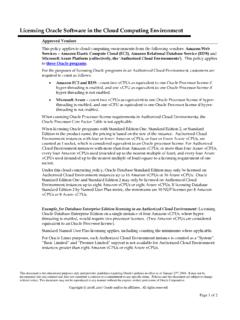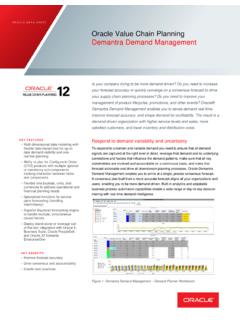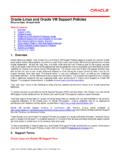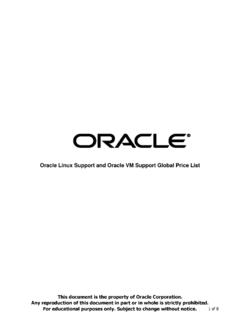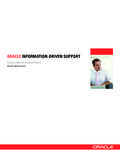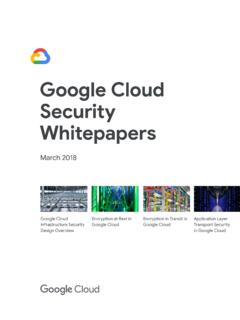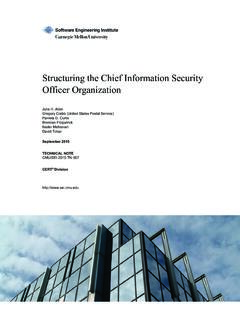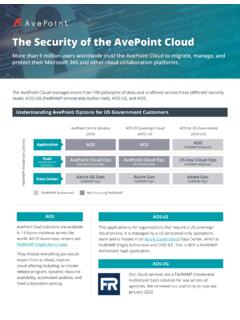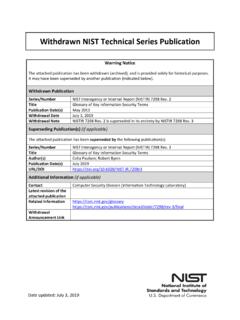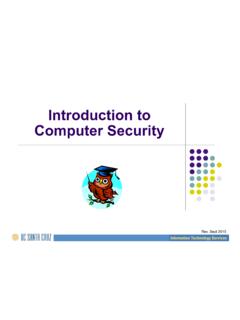Transcription of Oracle Cloud Infrastructure Security Architecture
1 1 Oracle Cloud Infrastructure Security Architecture / version Copyright 2021, Oracle and/or its affiliates / Public Business / Technical Brief Oracle Cloud Infrastructure Security Architecture September 2021, version Copyright 2021, Oracle and/or its affiliates Public 2 Oracle Cloud Infrastructure Security Architecture / version Copyright 2021, Oracle and/or its affiliates / Public Purpose Statement This document provides an overview of features and enhancements included Oracle Cloud Infrastructure (OCI). It s intended solely to help you assess the business benefits of OCI and to plan your IT projects. Disclaimer This document in any form, software or printed matter, contains proprietary information that is the exclusive property of Oracle . Your access to and use of this confidential material is subject to the terms and conditions of your Oracle software license and service agreement, which has been executed and with which you agree to comply.
2 This document and information contained herein may not be disclosed, copied, reproduced or distributed to anyone outside Oracle without prior written consent of Oracle . This document is not part of your license agreement nor can it be incorporated into any contractual agreement with Oracle or its subsidiaries or affiliates. This document is for informational purposes only and is intended solely to assist you in planning for the implementation and upgrade of the product features described. It is not a commitment to deliver any material, code, or functionality, and should not be relied upon in making purchasing decisions. The development, release, and timing of any features or functionality described in this document remains at the sole discretion of Oracle . Due to the nature of the product Architecture , it may not be possible to safely include all features described in this document without risking significant destabilization of the code.
3 Revision History The following revisions have been made to this document. DATE REVISION September 2021 Added information about Dedicated Region Cloud @Customer March 2020 Initial publication 3 Oracle Cloud Infrastructure Security Architecture / version Copyright 2021, Oracle and/or its affiliates / Public Table of Contents Overview 4 Security -First Design 4 First-Generation Public Clouds 4 Oracle Cloud Infrastructure Next-Generation Public Cloud 4 Platform Security 4 Isolated Network Virtualization 5 Hardware 5 Physical Network 6 Network Segmentation 7 Fault-Tolerant Infrastructure 8 Physical Security 8 Secure Connectivity 9 Least-Privilege Access 9 Multiple Authentication Layers 9 Internal Connectivity 9 External Connectivity 10 Dedicated Region Cloud @Customer 10 Operational Security 10 Defensive Security 10 Offensive Security 11 Security Assurance 11 Data and Application Protection 11 Data Access 11 Data Destruction 11 Data Encryption 12 API Security 12 Culture of Trust and Compliance 12 Development Security 12 Personnel Security 13
4 Supply-Chain Security 13 Compliance 13 Auditing 13 Conclusion 14 References 14 4 Oracle Cloud Infrastructure Security Architecture / version Copyright 2021, Oracle and/or its affiliates / Public Overview Oracle Cloud Infrastructure (OCI) is a next-generation Infrastructure -as-a-service (IaaS) offering architected on Security -first design principles. These principles include isolated network virtualization and pristine physical host deployment, which were previously difficult to achieve with earlier public Cloud designs. With these design principles, OCI helps to reduce risk from advanced persistent threats. OCI benefits from tiered defenses and highly secure operations that span from the physical hardware in our data centers to the web layer, in addition to the protections and controls available in our Cloud .
5 Many of these protections also work with third-party clouds and on-premises solutions to help secure modern enterprise workloads and data where they reside. This document describes how OCI addresses the Security requirements of customers who run critical and sensitive workloads. It details how Security is fundamental to the Architecture , data- center design, personnel selection, and processes for provisioning, using, certifying, and maintaining OCI. Security -First Design As Cloud has become more common, Security concerns have become more important. From its inception, Oracle Cloud Infrastructure prioritized solving the Security issues that grew out of first-generation clouds. First-Generation Public Clouds First-generation public clouds focused on the efficient use of hardware resources enabled by virtualization and use of a hypervisor.
6 These clouds were built on many of the same technologies and principles used in private clouds, which were designed so that expensive hardware resources didn t remain idle. Security sometimes wasn t a foundational principle of this design because private data centers relied on perimeter defenses. As public Cloud use became more common, so did concerns about attacks associated with hypervisor vulnerabilities. Security is a primary concern for enterprise customers, and the risk associated with the hypervisor design of first-generation public clouds was only growing. Oracle Cloud Infrastructure Next-Generation Public Cloud OCI is a Security -first public Cloud Infrastructure that Oracle built for enterprise critical workloads. Security -first means that Oracle redesigned the virtualization stack to reduce the risk from hypervisor-based attacks and increase tenant isolation.
7 The result is a next-generation public Cloud Infrastructure design that provides significant Security benefits over first-generation Cloud Infrastructure designs. We ve implemented this design in every data center and region. OCI is a complete IaaS platform. It provides the services needed to build and run applications in a highly secure, hosted environment with high performance and availability. Customers can run the Compute and Database services on bare metal instances, which are customer-dedicated physical servers, or as virtual machines (VM) instances, which are isolated computing environments on top of bare metal hardware. Bare metal and VM instances run on the same types of server hardware, firmware, underlying software, and networking Infrastructure , so both instance types have the OCI protections built into those layers.
8 Platform Security Oracle designed Oracle Cloud Infrastructure Architecture for Security of the platform through isolated network virtualization, highly secure firmware installation, a controlled physical network, and network segmentation. 5 Oracle Cloud Infrastructure Security Architecture / version Copyright 2021, Oracle and/or its affiliates / Public Isolated Network Virtualization Central to the OCI design is isolated network virtualization, which greatly reduces the risk from the hypervisor. The hypervisor is the software that manages virtual devices in a Cloud environment, handling server and network virtualization. In traditional virtualization environments, the hypervisor manages network traffic, enabling traffic to flow between VM instances and between VM instances and physical hosts.
9 This adds considerable complexity and computational overhead in the hypervisor. Proof-of-concept computer Security attacks, such as VM escape attacks, have highlighted the substantial risk that can come with this design. These attacks exploit hypervisor complexity by enabling an attacker to break out of a VM instance, access the underlying operating system, and gain control of the hypervisor. The attacker can then potentially access other hosts, sometimes undetected. OCI reduces this risk by decoupling network virtualization from the hypervisor. Oracle has implemented network virtualization as a highly customized hardware and software layer that moves Cloud control away from the hypervisor and host and puts it on its own network. This hardened and monitored layer of control is what enables isolated network virtualization.
10 Isolated network virtualization reduces risk by limiting the attack surface. Even if a malicious actor succeeds with a VM escape attack on a single host, they can t reach other hosts in the Cloud Infrastructure . The attack is contained effectively to the one host. Oracle has implemented isolated network virtualization in every data center in every region, which means that all OCI tenants benefit from this design. Figure 1: Isolated Network Virtualization Reduces Risk in the Oracle Next-Generation Cloud Hardware A primary design principle of OCI is protecting tenants from firmware-based attacks. Threats at the firmware level are becoming more common, which raises the potential risks for public Cloud providers. To ensure that each server is provisioned with clean firmware, Oracle has implemented a hardware-based root of trust for the process of wiping and reinstalling server firmware.
